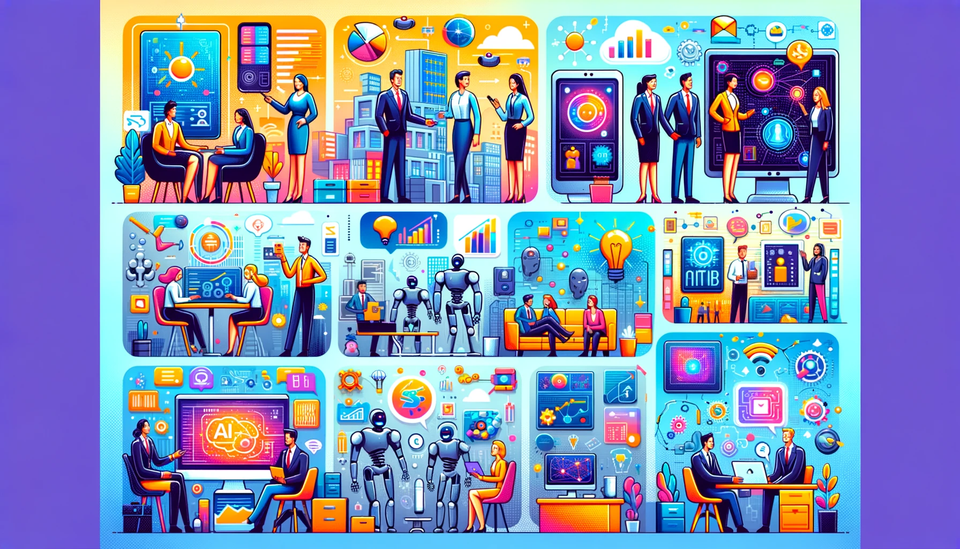- In the bustling corridors of a modern corporation, the hum of conversations is occasionally interrupted by the subtle beeping of machines. Leaders huddle around sleek conference tables, eyes fixed on presentations that promise a glimpse into the future. Amidst this dynamic environment, a guide emerges — a beacon for those navigating the complexities of the digital age. "Applied Artificial Intelligence: A Handbook for Business Leaders" by Mariya Yao, Adelyn Zhou, and Marlene Jia is not just a book; it is a compass for those ready to embark on the transformative journey of AI adoption.
- Introduction: Setting the Stage
- The introduction to this comprehensive guide serves as a rallying cry for business leaders. It seeks to bridge the often daunting gap between the technical intricacies of AI research and the practical necessities of business application. The authors, well-versed in the world of AI, craft their narrative for executives who need actionable insights rather than deep technical dive. The goal is clear: to provide a roadmap that balances technical knowledge with strategic guidance, ensuring leaders are equipped to harness AI's potential effectively.
- Chapter 1: Unveiling AI for Business
- Imagine walking into a vast library where each book represents a facet of artificial intelligence. The first chapter serves as your librarian, guiding you through the essential concepts. AI, in its essence, is the simulation of human intelligence by machines. Within this broad spectrum lies machine learning, a subset where machines learn from data, and deep learning, a powerful technique using neural networks to identify patterns.
- The narrative paints a vivid picture of AI's potential, from automating mundane tasks to offering deep insights that can drive strategic decisions. However, it doesn't shy away from the hurdles. Quality data is the lifeblood of AI, yet many organizations struggle with data collection and management. Furthermore, a shortage of skilled professionals and cultural resistance within organizations can impede progress. Yet, the chapter closes on a hopeful note, emphasizing that with careful planning and strategy, these challenges are surmountable.
- Chapter 2: AI in the Enterprise
- The journey continues into the heart of the enterprise, where AI's impact is vividly illustrated across various business functions. Picture a marketing team using AI to analyze customer data, segment audiences, and personalize campaigns. This isn't a distant dream but a present reality, exemplified by tools like Salesforce’s Einstein. In customer service, AI-driven chatbots like Amtrak’s Julie handle routine inquiries, freeing human agents to tackle more complex issues.
- The narrative traverses through human resources, where AI automates resume screening and evaluates employee engagement, to supply chain logistics, where machine learning models optimize inventory and forecast demand. Each example, from Unilever’s AI-driven hiring platform to Amazon’s automated warehouses, showcases AI's transformative power. The underlying message is clear: successful AI integration requires understanding specific departmental challenges and leveraging AI to address them.
- Chapter 4: Building a High-Performing AI Team
- As the narrative unfolds, the importance of building a robust AI team comes to the forefront. Imagine a symphony, where each musician plays a crucial role in creating a harmonious performance. Similarly, a successful AI initiative requires a blend of talents. Data scientists, data engineers, AI/ML engineers, domain experts, and product managers must collaborate seamlessly.
- Leadership and governance are pivotal. A Chief AI Officer can steer AI projects towards strategic goals, while a robust governance framework ensures ethical and effective AI deployment. The chapter emphasizes the need for attracting and retaining top talent through competitive compensation, clear career growth opportunities, and a culture that fosters creativity and continuous learning. This narrative is not just about assembling a team but nurturing a collaborative environment where AI initiatives can thrive.
- Chapter 5: The Lifeblood of AI - Data and Infrastructure
- The narrative then delves into the critical realm of data and infrastructure. Picture a bustling marketplace where data flows like currency. Internal data from customer transactions and operations, external data from third-party sources, and synthetic data created to simulate real-world patterns form the foundation of AI systems. Ensuring data quality and implementing a strong governance framework are paramount.
- The chapter explores the architectural choices between data lakes and data warehouses, the benefits of cloud storage, and the need for ETL pipelines that automate data preparation. The computing infrastructure, whether on-premises or in the cloud, must be scalable and equipped with specialized hardware like GPUs for deep learning tasks. The narrative underscores that without high-quality data and robust infrastructure, AI initiatives cannot achieve their full potential.
- Chapter 6: From Concept to Reality - Implementing AI
- As the journey progresses, the focus shifts to implementing and operationalizing AI. Imagine a startup incubator where innovative ideas are transformed into tangible products. Similarly, AI projects should start with pilot initiatives that demonstrate potential and build momentum. The deployment of AI models requires standardized pipelines and strategies for both batch and real-time processing.
- Scalability and integration are crucial for AI systems to adapt to growing data loads and business needs. Monitoring tools track model performance, ensuring they remain accurate and unbiased. Governance frameworks and change management strategies prepare organizations for the operational shifts AI brings. This chapter is a blueprint for turning AI from a conceptual idea into a practical, value-generating reality.
- Chapter 7: Cultivating a Data-Driven Culture
- No AI journey is complete without a cultural transformation. Imagine a garden where data literacy is the fertile soil nurturing innovative ideas. Executive support is crucial in fostering a data-driven culture. Leaders must communicate a compelling vision and invest in data analytics tools and infrastructure. Promoting data literacy across all levels of the organization ensures that employees can effectively interpret and utilize data.
- Empowering data ownership within departments, fostering cross-functional collaboration, and encouraging experimentation are key to embedding AI into the organizational DNA. Ethical considerations and responsible AI practices ensure fairness and transparency. The narrative illustrates that a data-driven culture is not just about technology but about transforming mindsets and practices to leverage AI's full potential.
- Chapter 8: Gazing into the Future of AI
- The narrative concludes with a forward-looking perspective on AI's future in business. Imagine standing at the edge of a vast horizon, where emerging AI applications promise new possibilities. Advancements in natural language processing, computer vision, and reinforcement learning will revolutionize customer support, security systems, and decision-making processes.
- Industry-specific developments in healthcare, finance, and manufacturing showcase AI's potential to enhance disease detection, refine financial strategies, and optimize production processes. However, as AI becomes more integrated into business, ethical considerations around data privacy and job displacement will require attention. The chapter emphasizes that human-AI collaboration will be essential, with AI tools augmenting human expertise and creativity.
- The democratization of AI through open-source tools and AI-as-a-service platforms will make AI accessible to more organizations, leveling the playing field. The global impact of AI will reshape economic dynamics, and collaboration between nations will be crucial for addressing global challenges.
- As we close this narrative journey through "Applied Artificial Intelligence: A Handbook for Business Leaders," it becomes evident that AI is not just a technological innovation but a transformative force reshaping businesses and society. The guide by Mariya Yao, Adelyn Zhou, and Marlene Jia offers a comprehensive roadmap for leaders ready to embrace this transformation. By understanding AI's potential, building the right teams, ensuring robust data and infrastructure, and fostering a data-driven culture, organizations can navigate the complexities of AI adoption and unlock its full potential. The future of AI is not a distant horizon but a journey we embark on today, armed with the knowledge and insights from this invaluable handbook.


Member discussion